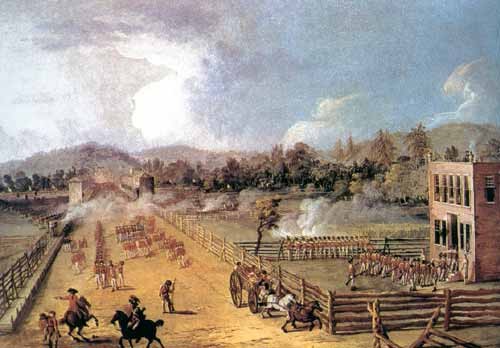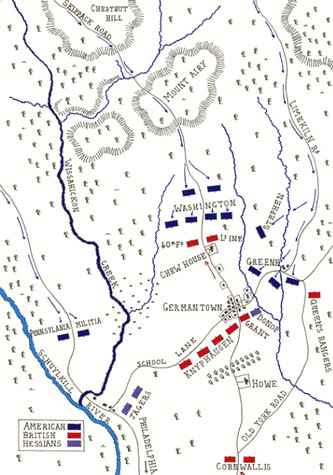Battle of Germantown
Introduction
Text-to-speech Audio
Images
This is an illustration of the Battle of Germantown around the Chew House. Germantown was a major loss for the American army.

American forces devised this plan to assault Germantown. The complexity of the plan led to the eventual demise of the army.

Backstory and Context
Text-to-speech Audio
Months before the rallying victory at Valley Forge, General George Washington found himself in a terrifying position. A number of defeats at the hand of experienced British General William Howe had left the Continental Army harried and ousted from the strategically and politically vital city of Philadelphia, Pennsylvania.
Bloody defeats in the Battles of Brandywine and Paoli and the loss of Philadelphia to the British meant that Washington and the Continental Army were not only desperate for a victory for the purposes of political solvency but also for strategic purposes; winter was quickly approaching, and the city of Philadelphia was a strong position in which the British could winter their troops.
Together with a group of skilled commanders, General Washington devised a plan to breach the British defensive line with a surprise attack and crush the bulk of their forces before they could respond. The attack was to begin at Germantown, where General Howe had stationed over 9000 of his troops. The Continental Army at this time was close to 11,000 strong, outnumbering the British forces at Germantown significantly. With numbers on their side, General Washington split his forces into four columnns which were to approach Germantown from different directions, surrounding and pinning the British forces in totality.
Upon the initiation of the attack, a dense fog set in, which was only complicated further as fighting began and gunpowder smoke clouded the air. With visibility severely reduced, the American forces broke from the strategy unintentionally and then fell into confusion.
General Sullivan, one of Washington’s generals, marched into the fog alongside two other partitions of troops to engage the British forces. In a mildly successful attempt at pinning down the British, Sullivan’s partition fired continually on the defensive positions that lay before them. Their attack was so aggressive that they quickly ran out of ammunition and had to retreat. The other partitions of troops lost track of their fellows and panicked into retreat as well.
At some point during the retreat, a portion of troops under the control of General Wayne and a portion of the troops under General Greene came across one another out of position and with extremely low visibility. This resulted in the two partitions attacking one another under the impression that the other partition was enemy troops attempting to flank. Shortly afterward, the actual forces of the British did, indeed, flank and forced a full withdrawal of Wayne’s troops and the remaining segment of Greene’s troops that had become lost.
General Greene’s main force, however, met more success than the other groups, breaking through a number of British defensive positions before ultimately coming up against two large hosts of British troops under General Cornwallis (the same general who would later surrender to Washington at Yorktown, marking the most significant victory of the Continental forces.) Greene was forced to withdraw when he was notified of the losses the rest of the Continental forces had endured.
Elsewhere in Germantown, taking advantage of the low visibility, 120 of General Howe’s men slipped into the Mansion of Chief Justice Chew, also known as Cliveden and fortified the position heavily against the Continental Army, following the orders of Colonel Musgrave of the British Army. General Washington, calling a council of war, concluded with the support of Brigadier General Henry Knox that Cliveden was a necessary strategic position and ordered his troops to attack it repeatedly.
Unfortunately for the Continental Army, the weaponry they possessed were unable to damage the heavy stone walls of Cliveden, and the mansion stood strong. The British fighters within were able to inflict heavy casualties on the Continental forces approaching, ultimately resulting in General Washington calling off the attack.
With the Continental forces retreating, Cornwallis’ troops attempted to pursue Greene. They were rebuffed, however, with the help of the remaining artillery that General Wayne had commanded. General Howe decided not to press the pursuit, instead opting to bring his troops inward to Philadelphia. This decision proved to make the battle, which by all accounts appeared to be a bloody loss for the Continental Army, a significant win for the greater progress of the war for two reasons.
The first reason was that the battle impressed the leadership of France, which led to their decision to formally ally themselves with the Americans. While some leaders at the time were surprised by this decision, the French court reasoned that the fact that the Continental Army had assembled, organized itself, and launched an aggressive attack on a well-fortified position in less than a year of war was a sign of the value of an alliance.
Secondly, Washington was able to retreat for the winter at Valley Forge, opening the door for the retaking of Philadelphia following an incredibly harsh winter. While the winter at Valley Forge was one of the most difficult of the entire war for the Americans, it left Washington and his army in the perfect position to capitalize on General Howe’s mistake to split his forces in hopes of taking New York City.
Germantown has gone down in history as an incredibly influential battle in American history. Despite its bloody outcome for the young Continental Army, the Battle of Germantown embodied the age-old adage of the Pyrrhic victory in which the British won the battle, but ultimately lost the war. To this day, an annual reenactment of the Battle of Germantown is held on the same grounds upon which the original battle was fought, and Germantown, Pennsylvania, bears many references to the battle’s historical impact.